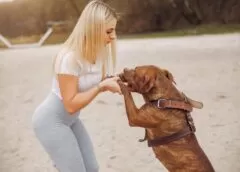A new puppy brings delight to your family. His rambunctious antics and affectionate responses have everyone giggling with happiness. Indeed, his loyalty and affection will be a part of your family for many years to come. But this depends on the training which you are just now beginning. Here are some tips to help you complete this training successfully.
If you have gotten a new dog or puppy, you should work on training them right away. If they are going to be indoor dogs, you can start crate training them. This prevents bathroom accidents or your items from being chewed on. Please start with the right-sized crate so that they have enough room in the crate to move around a bit.
When teaching your dog discipline, you should always apply it with speed and consistency regardless of your training method. Not correcting your dog for bad behavior every single time sends him mixed signals that may only worsen the problem. Likewise, not correcting your dog immediately may make it hard for him to understand why you are punishing him.
Stay consistent when it comes to feeding your dog. Your dog should be fed at the same time every day, and they should only have a certain amount of time to eat. Soon your dog will be finished with the meal before you are ready to remove the dish.
It takes many repetitions before a dog can learn new commands. Before your dog understands it, it may take about 25-50 repetitions of a particular command. Be patient and continue using a command until your dog learns it.
It is essential to add play to the training sessions when training your dog. This will help keep your dog interested. Play with his toy and show him how much fun you are having. This will help a dog with low motivation to stay interested. Don’t shove it at him when you want him to take a toy. Make him take it from you.
When doing a training session with your dog, set a specific goal for that session. When you reach that goal, end the session, even if you plan to go longer. This helps keep both you and your dog focused on the results and ensures that each session ends positively.
Stimulate your dog every day to help prevent nuisance behaviors, such as barking. A bored dog is more likely to bark continuously to gain attention. If you get your dog out for regular walks and exercise, you may find that this behavior stops. You will have a happier dog and be a happier owner.
If you’re leash-training a puppy, the initial step needs to be putting a collar on them when you play with them. Ensuring your puppy is comfortable wearing its collar is essential for several reasons. First, this helps you use the leash properly. Second, it ensures that your puppy can be identified if the leash gets taken off.
When training your dog, one tip to keep in mind is never to discipline your dog for bad behavior when he is ill. This will only confuse your dog and might cause him not to respond to discipline in the future. Examples of this would be if your dog vomits or defecates in a not typical manner of his normal behavior.
A great dog training tip is that if it seems like you can’t get your dog to listen or learn on a particular day, you should check your dog to notice any symptoms of illness. Some other indicators that your dog is sick could be that he is sleeping excessively or has stopped eating. By paying attention to your dog’s symptoms, you’ll be able to get him to the veterinarian quicker.
If your dog is accompanying you on a trip, bring whatever your dog needs for sleeping, eating, and eliminating. Items such as food and water dishes are essential when traveling. Items like food can be left at home. Purchase some when you reach your destination.
The best way to potty train a new puppy is to pay attention! Keep your puppy where you can see him constantly. If you notice him sniffing around or starting to circle, quickly pick him up and take him outside. These are signs that he is ready to go potty.
If you do not communicate that biting is unacceptable, your puppy doesn’t know he is doing something wrong. When you catch your puppy biting, redirect him to a chew toy or bone. As soon as the pup starts to bite, firmly say “No!” and give him the chew toy. While you are teaching a puppy to stop biting, do not play any wrestling or tug of war games with them to strengthen what you are teaching.
A great way to potty-train your puppy is to crate train it. A dog won’t potty where it sleeps, so keep the puppy in his crate and let him out for a potty break at regular intervals, and he will go. Eventually, your pup will learn that bathroom time is outdoor time. This type of training also prevents many accidents.
Remember that you are in charge when you are walking your dog. You lead the dog, and he does not lead you. Use a training collar, and see that your dog follows you by going ahead of it when you pass through gates or doors. Remember, you’re the leader!
To stop your dog from jumping up on you, push him back firmly with your knee and tell him “NO” in a firm and commanding voice. As soon as his feet are on the floor, pet him with your hands and praise him for being a good dog with his feet on the floor.
With these tips, you are ready to proceed confidently with your puppy’s training. Consistency and attentiveness will win out over his unbridled impulsiveness. You want your pet to fit into your family life and become a faithful friend for many years. Following these training tips can pay off with just that result.


